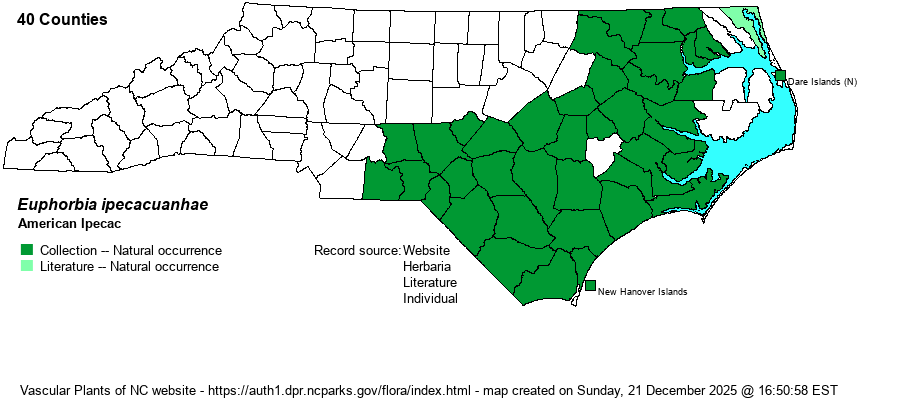| Author | L. | |
| Distribution | Sandhills, Coastal Plain; also on the Outer Banks and barrier islands, where rare. Rare in the lower Piedmont.
Mostly Coastal Plain, southwestern CT and Long Island south to east-central GA. | |
| Abundance | Frequent to generally common in the most favorable habitats (e.g., xeric sands) -- such as the Sandhills and parts of the Southern Coastal Plain; otherwise uncommon to infrequent in much of the remainder of the central and northern Coastal Plain. | |
| Habitat | Xeric to dry Longleaf Pine-Wiregrass uplands, sandhills, Carolina bay rims, openings in other pine-oak woodlands, stable dune barrens. |
| Phenology | Flowering and fruiting late February-May; later in response to fire. Formerly used by Native Americans as an emetic and laxative. | |
| Identification | American Ipecac is a remarkable little plant and with highly variable stem and leaves. Below ground the rootstock penetrates deeply (RAB [1968] says "many feet"), whereas above ground there may be only a couple of small leaves hugging the sand or many leaves on a multi-branched stem as much as 8 inches long (along the ground). Leaves vary from plant to plant and even within one individual: linear, lance-shape, ovate, and even rotund; 1 inch to occasionally 4 inches long. The inflorescence is small and yellow-green, but conspicuous, owing to numerous flowers, always very close to the ground. This is the familiar decumbent, ground-hugging or sprawling "Euphorb" of sandy soil, often with glaucous blue-green leaves, and typically with quite a few variable leaf shapes on a single plant. The small yellowish flowers do attract attention, mainly because each plant can have 20 or more flowers. | |
| Taxonomic Comments | None
| |
| Other Common Name(s) | Carolina Ipecac, Wild Ipecac. Oddly, no website or reference seems to use the word "Spurge" in its common name. | |
| State Rank | S4 | |
| Global Rank | G5 | |
| State Status | | |
| US Status | | |
| USACE-agcp | | |
| USACE-emp | | |

